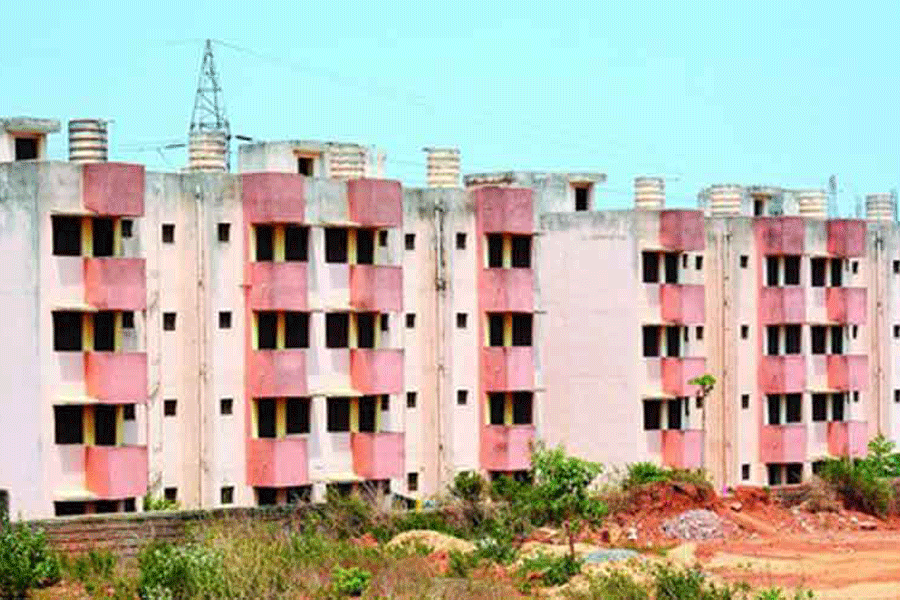Two of the central government’s key rural welfare programmes have witnessed poor progress in the first quarter of this financial year, shows a report released by the National Statistical Office, which functions under the ministry of statistics.
One of these programmes is the Pradhan Mantri Awas Yojana Grameen (PMAY-G), the country’s main rural housing scheme. The other is a key feature of the Deendayal Antyodaya Yojana-National Rural Livelihood Mission (DAY-NRLM) that aims to provide low-interest bank loans to individuals via women’s self-help groups.
The National Statistical Office (NSO) compiled the report, “Twenty Point Programme-2006: Progress Report for the Period April to June 2023”, on the basis of data received from central ministries and state governments.
The report shows that less than 4.97 lakh houses were built under the PMAY-G between April and June this year against a target of about 14.18 lakh – a success rate of just 35 per cent. However, several states including Bengal and Uttar Pradesh did not provide their achievement data for this period.
The countrywide target for the financial year 2023-24 under the scheme is 56.71 lakh houses.
The DAY-NRLM is the Centre’s flagship anti-poverty scheme, aimed at building institutions for women in rural areas. One of its features is a “revolving fund” — a low-interest bank loan given to women’s self-help groups (SHGs) that can be re-loaned to a member or non-member in need at a slightly higher interest.
However, this is still lower than the interest the individual would have had to pay if they took the loan directly from a bank.
The government’s target was to provide revolving funds to 12.33 lakh SHGs in 2023-24, including 2.74 lakh SHGs in the first quarter. But barely 1.17 lakh SHGs (less than 43 per cent) received the funds between April and June (although data from Uttar Pradesh and Bengal remained elusive).
As for the PMAY-G, the Centre’s target is to achieve housing for all the 2.95 crore eligible families by March next year. These families were identified through the Socio-Economic Caste Census (SECC) 2011-12.
Social activist Nikhil Dey said that apart from slow progress, the PMAY-G also suffers from opacity.
“(Many) wrong (ineligible) people are provided the benefit. Some people who already have houses too get the funds, which they use for other purposes,” Dey said.
“There is no transparency in the selection of beneficiaries. A lot of tampering happens to the waiting list.”
Dey said the government must make its waiting lists of beneficiaries public by putting them up on walls in every village.
He said the target of 2.95 crore houses was set on the basis of the 2011-12 SECC’s findings, but many more deserving families had come up by now. “The government should help them too.”
Under the PMAY-G, the government provides a family with Rs 1.2 lakh in the plains and Rs 1.3 lakh in the hills to build a house.
The NSO report says the performance of six welfare programmes has been poor in the April-June quarter this year, while that of six others has been “very good”, with 90 per cent of the target, or more, achieved.
The success stories include the Pradhan Mantri Gram Sadak Yojana, Integrated Child Development Services, electricity supply and the National Food Security Act.
Chopper offer to Philippines
New Delhi: India has offered the Philippines at least seven helicopters that will be used for the rescue and humanitarian efforts of the Philippine Coast Guard (PCG), sources said.
The helicopters that are to be provided to the PCG are built for India’s navy and coast guard, can be used for more active security operations and can carry more people and load.
Philippines President Ferdinand R. Marcos Jr said India’s offer would boost efforts to build up the country’s capabilities in terms of rescue and humanitarian efforts.
“We are trying to build up our capacity — our capabilities in terms of our cost guard, in terms of our — of course, the search and rescue is always the consideration,” he said.
IMRAN AHMED SIDDIQUI










